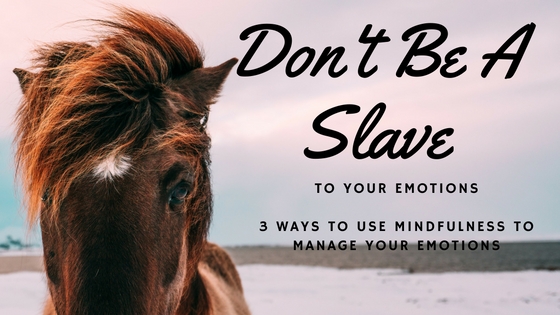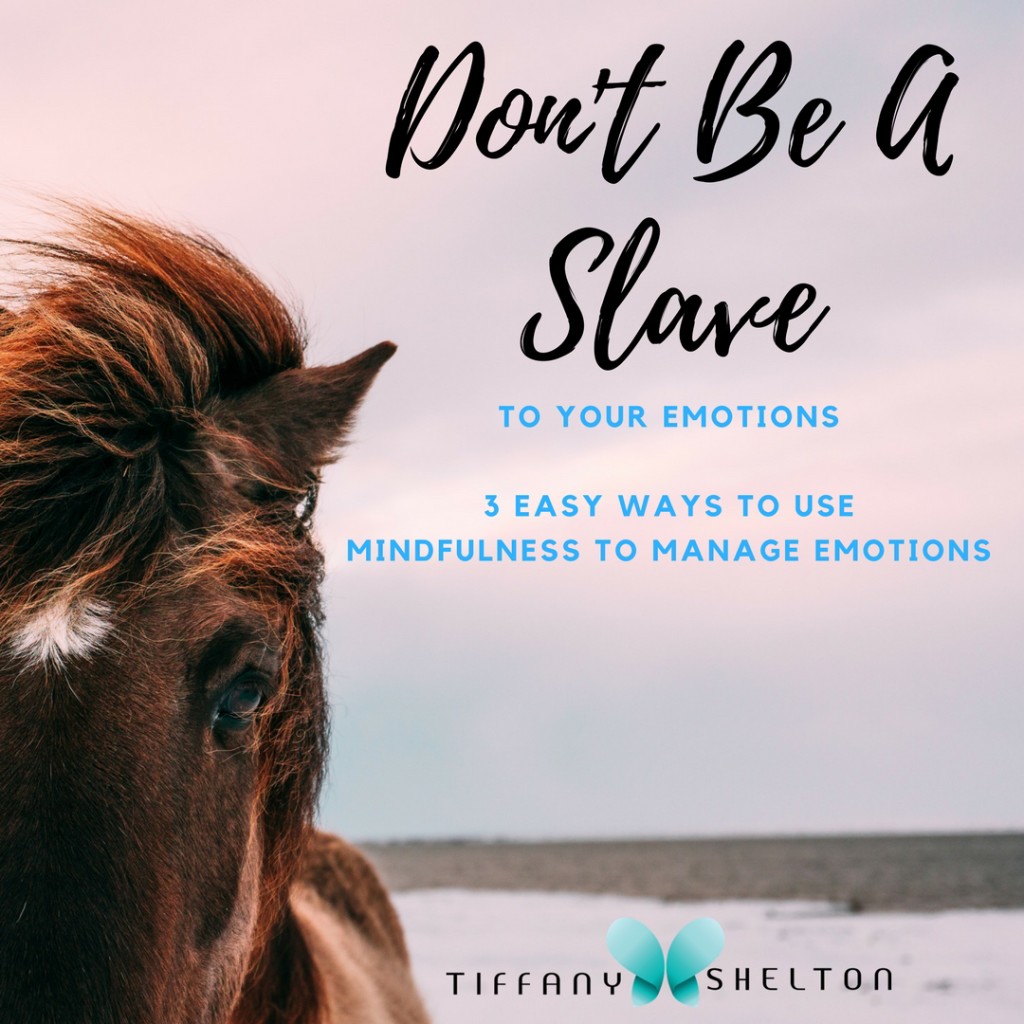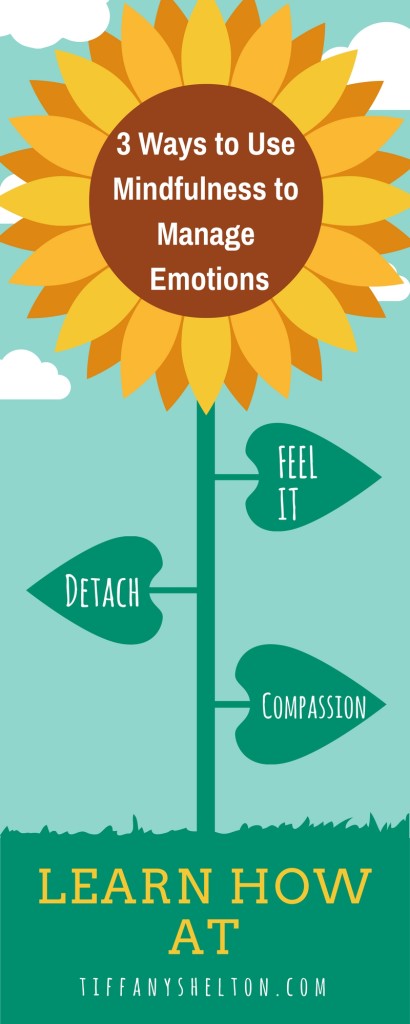“I don’t want to be at the mercy of my emotions. I want to use them, to enjoy them, and to dominate them.” – Oscar Wilde
– Tiffany Shelton, M.A. is a psychotherapist and consciousness expert. Her passion to elevate consciousness goes beyond the message of self-care or wellness, but instead consciously adds to these movements by demanding awakening and insight. Learn more about Tiffany Shelton by clicking here.
Sign Up for My Newsletter for a Dose of Consciousness Straight to Your Inbox!
Click Here
3 Easy Ways to Use Mindfulness to Manage Difficult Emotions
TD Jakes once said “Sometimes keeping it real will keep you broke”. We aren’t always in a position to express our emotions the way we would like to. Sometimes life makes its so that we have to put on a happy face in order survive and continue our journey towards thriving. This means that we don’t always have the luxury of stopping to fully process our emotions and thoughts and it is essential to learn how to not let these unprocessed emotions control our behavior, interactions, and productivity.
Therefore having a strategy to deal with difficult emotions like sadness and anger in the moment will help you learn from, process, and integrate them more consciously. When we let our emotions drive the car of life, we are blindly and unconsciously living a life guided by a false self. We are not our emotions, and this is the biggest gift.
Our identity is so much grander than any emotional state, fluctuating with life’s challenges and successes. Your True Self is eternal, unchanging, and simply is. In the Bible God says I am the Great I am. For me this is the central tenet of Buddhism, cognitive behavioral psychology, and yogic teachings that ask you to become the observer connected with the Great I am that dwells within.
Here are 3 ways you can manage your emotions and put your True self back in the driver seat.
One: Feel it
Founder of Mindfulness Based Cognitive Behavioral Therapy, Jon Kabbit Zinn, encourages us to embrace negative emotions asking us to become aware of our present emotions and say to ourselves “It’s already here, let me feel it”.
Generally having an attitude of turning towards difficult emotions (versus clinging to pleasure) will release you from the grips of your attachment to pleasure; which is what ultimately causes suffering. Most times clinging to pleasure and the utmost avoidance of any pain is what keeps us shackled to painful experiences.
Instead, the next time you notice anger, sadness, regret, or any other difficult emotion see if you can open yourself up to experiencing emotion.
Meditation Exercise
You can practice this meditation exercise quickly the next you feel upset. Take 3 minutes and find a quiet place to focus on identifying present emotions felt and opening up to them.
- Approach them with a sense of curiosity asking the emotion “What did you come to teach me?” This will cultivate your identity separate from the emotion.
- Mentally scan your body using your mind’s eye to envision your whole body. Notice where you feel the emotion in your body and use your breath to breathe deeply into this space.
Two: Release It
In Buddhist tradition annica is one of the three characteristics of existence, and states that everything is a “constant state of fluctuating matter and energy”. This suggests that our emotions are fluctuating as well, and whatever you are feeling “this too shall pass”.
Becoming conscious of our fluctuating emotions allows us to separate our stable identity from any fluctuating emotion. So once you feel the emotion, take steps to not over identify with it and allow it to pass.
In Ashtanga Yoga, the fourth limb of yoga, Pratyhara, is the first step towards meditation. It teaches us to withdraw from our senses and separate our identities from any felt experience. After we use the breathe to connect the mind and body (Pranayama), we focus our attention inwards. As we begin to notice sensations, thoughts, and emotions, we accept them without judgement then separate our soul identity from them and let them go.
Meditation Exercise
Vipassana meditation is a Buddhist form of meditation that lends itself well to managing emotional states. Thoughts directly impact our emotions, and this form of meditation focuses on acknowledging thoughts and letting them go.
Here’s how to start:
- Allow yourself to come into a comfortable seated meditation position.
- Become present by focusing on the breath and taking a couple of deep breathes in and out.
- Gently release the breath and refocus on your thoughts. Become an observer of your thoughts.
- With each thought that comes say to yourself: “This is what I am thinking not who I am, so I can let it go”
- Gently let the thought go without attaching to it
- Sit patiently and continue to notice your thoughts
- Repeat this process with the next thought that arises and continue like this throughout your meditation session.
- When you are done meditating ,write down any themes you noticed so that you become keenly aware of your internal dialogue.
- Then as symbolic gesture, throw the piece of paper away and reaffirm that you are not your thoughts nor emotions.
Three: Compassion
In a fast paced world that doesn’t always give us time to process our emotions in the present moment, it is important to have compassion for yourself and others. Cultivate compassion into your everyday routine and find ways to cultivate compassion and empathy. Many times when we experience hurt feelings, it is either 1) not the other person’s intention or 2) the other person is dealing with their own pain that is being directed at you.
Take your power back and give yourself and others the benefit of the doubt. The next time you feel guilty or sad, try to expand your compassion for yourself. The next time someone angers you, see if you could see how they came to this behavior and put yourself in their shoes.
Mindfulness Exercise
The next time you are feeling particularly moody or know that you are going to be around someone who emotionally triggers you practice this exercise.
- Start your day with the mindful intention to have compassion for yourself and others.
- Throughout the day make a commitment to check internal dialogue, and correct yourself after any critical and judgmental thoughts.
- Throughout the day, mindfully give people the benefit of the doubt
– Tiffany Shelton, M.A. is a psychotherapist and consciousness expert. Her passion to elevate consciousness goes beyond the message of self-care or wellness, but instead consciously adds to these movements by demanding awakening and insight. Learn more about Tiffany Shelton by clicking here.
Sign Up for My Newsletter for a Dose of Consciousness Straight to Your Inbox!
Click Here






